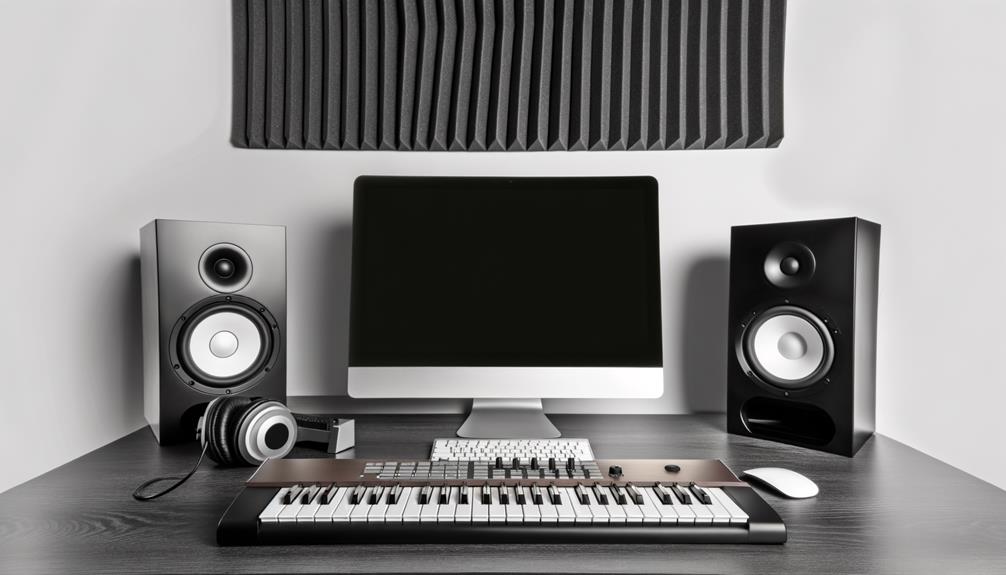No products in the cart.
To master music tracks successfully, you’ll need to focus on five key areas. First, optimize your equalization settings using linear EQ for clean, precise adjustments without altering the original sound. Second, control your dynamics effectively; subtle compression helps maintain consistent energy. Third, balance the stereo field with strategic panning and stereo widening tools, ensuring mono compatibility for critical sounds. Fourth, enhance the overall tone by making subtle EQ adjustments and using multiband compression for tonal consistency. Finally, apply limiting carefully to boost loudness without clipping, setting the limiter’s output between -0.3dB and -0.8dB. There’s more to explore that can refine your mastering skills further.
Contents
hide
Key Takeaways
- Use linear EQ to enhance frequency accuracy while preserving the original sound.
- Apply subtle compression to achieve uniformly balanced dynamics across the track.
- Employ stereo widening and strategic panning for a balanced and spacious soundstage.
- Compare and adjust EQ settings with industry-standard references for optimal tonal balance.
- Precisely apply limiting to increase loudness without compromising on clarity and dynamic range.
Optimize Equalization Settings
To optimize equalization settings in mastering, start by utilizing a linear EQ for precise tonal adjustments. This technique enhances frequency accuracy and maintains the integrity of the original sound. You’ll find that linear EQ allows for clean, transparent modifications without introducing phase distortion, essential for high-quality mastering.
When adjusting the EQ, aim for wide cuts and boosts to affect the tonal balance subtly. These broad adjustments are less invasive than narrow tweaks, which can lead to unnatural sounds. The key is to enhance the track without altering its inherent character. You’re not just fixing the mix; you’re refining it, ensuring it translates well across various playback systems.
Focus on EQ precision, a cornerstone of mastering techniques. This isn’t about drastic changes but rather fine-tuning. Listen critically—small shifts can have a significant impact on the overall balance. Compare your work against reference tracks frequently to check your progress. This comparison ensures you’re on target with the genre standards and listener expectations.
Control Dynamics Effectively
Mastering engineers often apply subtle compression to guarantee the track’s dynamics are uniformly balanced, enhancing both cohesion and sound quality. By focusing on the dynamic range, you make sure that the loudest and softest parts of your track hold a consistent energy, which is vital for professional results.
Adjusting attack and release times correctly prevents the natural vibe of your track from being lost. This tweaking is essential for transient shaping, which preserves the punchiness of percussive sounds while maintaining clarity.
| Parameter | Purpose |
|---|---|
| Attack Time | Controls how quickly compression starts; affects transients. |
| Release Time | Determines how compression eases off; impacts overall feel. |
| Ratio | Sets the level of compression applied to signals over the threshold. |
| Threshold | Defines the level at which compression begins. |
| Make-up Gain | Compensates for the gain reduction due to compression. |
Careful calibration of these settings ensures that minor dynamic adjustments enhance sound quality without compromising the track’s integrity. You’ll find that balancing these compression levels leads to a smoother, more polished final master, adeptly managing perceived loudness and preserving artistic intent.
Balance the Stereo Field
After controlling dynamics effectively, focus on using stereo widening tools to create a spacious and immersive soundstage that enhances your music’s overall impact. Employing strategic panning techniques allows you to distribute various elements across the left and right channels, which is vital for achieving a balanced stereo image. Be meticulous in positioning lead vocals, main instruments, and critical sounds centrally or slightly off-center, as they form the core of your track.
To avoid the pitfalls of excessive stereo width—such as phase cancellation or a disconnected sound—integrate mid/side processing into your mastering chain. This technique lets you manage and tweak the side (stereo) content separately from the mid (mono) content, enhancing both depth and clarity without compromising the integrity of the stereo image.
Lastly, don’t overlook the importance of mono compatibility. Regularly toggle your mix to mono to ensure all essential elements remain perceivable. This practice confirms that your track won’t lose its impact on mono playback systems, which are still prevalent in various listening environments. By mastering these aspects of stereo imaging, you’ll guarantee a rich and well-balanced auditory experience.
Enhance Overall Tone
Enhancing your track’s overall tone begins with judiciously using linear EQ to make subtle adjustments, guaranteeing a clean and balanced output. When mastering, your goal is to refine the audio, subtly manipulating frequencies for best tone shaping. Here’s how you can achieve precise sound enhancement:
- Reference Track Comparison: Regularly compare your track to industry-standard references to align the tonal balance and maintain consistency.
- Subtle EQ Adjustments: Focus on small EQ changes; avoid wide boosts and cuts. This precision in frequency manipulation maintains the track’s integrity while enhancing its clarity.
- Multiband Compression: Utilize this tool to address tonal inconsistencies across various frequency bands, smoothing out the overall sound without drastic alterations.
- Avoid Over-EQing: Excessive equalization can lead to an unnatural sound. Stick to minimal, necessary tweaks for effective audio refinement.
Apply Limiting Precisely
To effectively increase your mix’s loudness while avoiding clipping, apply limiting with precision. Understanding the exact threshold where limiting should begin is pivotal in gain staging — a foundational aspect of mastering techniques. By setting your limiter’s output level cautiously between -0.3dB and -0.8dB, you leave a safe margin that prevents digital distortion, maintaining the sonic integrity of your track.
Using a high-quality third-party limiter can greatly enhance your control, providing up to 45dB of gain reduction. However, with standard stock limiters, aiming for around 23dB of gain reduction will suffice to reach industry-standard loudness without compromising dynamic range. This careful balance ensures your master is both competitive and appealing when distributed.
Here’s a quick reference table to guide your limiting settings:
| Parameter | Stock Limiter Setting | Third-party Limiter Setting |
|---|---|---|
| Output Level | -0.3dB to -0.8dB | -0.3dB to -0.8dB |
| Gain Reduction | Up to 23dB | Up to 45dB |
| Ideal Application | Amateur Productions | Professional Releases |
| Purpose | Industry Loudness | Optimal Control |
| Impact | Prevent Clipping | Enhance Dynamics |
Frequently Asked Questions
How Do You Master a Song Perfectly?
To master a song perfectly, balance frequencies with EQ, apply subtle compression for dynamic consistency, and use stereo widening for precise imaging. Reference tracks help, and don’t forget limiting for uniform loudness.
What Are the Basics of Mastering a Track?
Mastering a track involves refining it in a controlled listening environment using specific tools like EQ and compressors to guarantee it sounds consistent and impactful across various playback systems.
What Should I Aim for When Mastering?
When mastering, you should aim for volume consistency and genre specificity to guarantee your track competes well. Focus on dynamic range and clarity to maintain both a polished and impactful sound.
How Do I Master My Track?
To master your track, start by setting clear loudness targets. Use stereo enhancement techniques for a wider soundstage, then apply EQ, compression, and limiting to achieve a balanced and professionally polished final product.
Conclusion
Now that you’ve got the essentials, mastering your music tracks should be a breeze.
Always refine your equalization settings to guarantee clarity.
Control your dynamics meticulously; it’s essential for a balanced sound.
Pay attention to the stereo field to achieve a full, immersive experience.
Enhance the overall tone to bring life to your track.
Finally, apply limiting with precision to avoid distortion while maximizing volume.
Stick to these guidelines, and you’ll produce professionally polished tracks every time.




